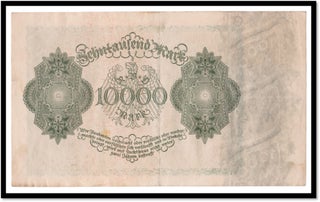Genuine Historical 1922 Weimar Germany 10000 Reichsbanknote ‘Vampire Bill’
The 10,000 German Mark bill issued in 1922 was the largest denomination issued to that date, distributed in Germany from January 1922 to November 1923.
Once folded in the middle, the note is still stiff with moderate age-toning. 210 mm by 124 mm (8.3 in by 4.9 in). Blue-green on olive-green under print. Reverse: Blue-green on olive-green fonts and symbols. Imperial eagle between "10000" [Large Issue P#71]
Very Good. Item #16721
Following their defeat, the Treaty of Versailles obligated Germany to pay reparations, which increased the nation’s financial struggles. The German government attempted to solve this problem by printing more money, which led to severe inflation.
The front of the note features a 1499 painting by Albrecht Durer titled “Portrait of a Young Man”.
This note depicts the anti-French sentiment held by most Germans at the time. Although Durer’s painting “Portrait of a young man” was chosen to be on the banknote, this painting was slightly altered by the engraver at the Reichsdruckeri, who had altered the banknote in the neck of the portrait to depict a rather gothic looking vampire, representing France, which is sucking the life blood out of the throat of Germany through reparations for World War I.
Difficult to notice at first but if the bill is turned and one’s focus is on the neck it can be clearly seen. [reference – ushmm; Numista]
Price: $12.00




![Havana, Cuba, Legal Affairs; 19th century letters] Letter dated January 1, 1818](https://blindhorsebooks.cdn.bibliopolis.com/pictures/014533.jpg?width=320&height=427&fit=bounds&auto=webp&v=1647176536)
![ALS, West Indies] A two-sided Author-Signed-Letter in violet ink detailing a voyage and. A. S. Carter, A. S. or Cates.](https://blindhorsebooks.cdn.bibliopolis.com/pictures/013896.jpg?width=320&height=427&fit=bounds&auto=webp&v=1647125383)

![Havana, Cuba] 1836 Shipping Document](https://blindhorsebooks.cdn.bibliopolis.com/pictures/014481.jpg?width=320&height=427&fit=bounds&auto=webp&v=1647178818)